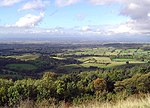Battle of the Standard

The Battle of the Standard, sometimes called the Battle of Northallerton, took place on 22 August 1138 on Cowton Moor near Northallerton in Yorkshire, England. English forces under William of Aumale repelled a Scottish army led by King David I of Scotland. King Stephen of England, fighting rebel barons in the south, had sent a small force (largely mercenaries), but the English army was mainly local militia and baronial retinues from Yorkshire and the north Midlands. Archbishop Thurstan of York had exerted himself greatly to raise the army, preaching that to withstand the Scots was to do God's work. The centre of the English position was therefore marked by a mast (mounted upon a cart) bearing a pyx carrying the consecrated host and from which were flown the consecrated banners of the minsters of York, Beverley and Ripon: hence the name of the battle. This cart-mounted standard was a very northerly example of a type of standard common in contemporary Italy, where it was known as a carroccio. King David had entered England for two declared reasons: To support his niece Matilda's claim to the English throne against that of King Stephen (married to another niece) To enlarge his kingdom beyond his previous gains. David's forces had already taken much of Northumberland apart from castles at Wark and Bamburgh. Advancing beyond the Tees towards York, early on 22 August the Scots found the English army drawn up on open fields 2 miles (3 km) north of Northallerton; they formed up in four 'lines' to attack it. The first attack, by unarmoured spearmen against armoured men (including dismounted knights) supported by telling fire from archers, failed. Within three hours, the Scots army disintegrated, apart from small bodies of knights and men-at-arms around David and his son Henry. At this point, Henry led a spirited attack with mounted knights; he and David then withdrew separately with their immediate companions in relatively good order. Heavy Scots losses are claimed, in battle and in flight. The English did not pursue far; David fell back to Carlisle and reassembled an army. Within a month, a truce was negotiated which left the Scots free to continue the siege of Wark castle, which eventually fell. Despite losing the battle, David was subsequently given most of the territorial concessions he had been seeking (which the chronicles say he had been offered before he crossed the Tees). David held these throughout the Anarchy, but on the death of David, his successor Malcolm IV of Scotland was soon forced to surrender David's gains to Henry II of England. Some chronicle accounts of the battle include an invented pre-battle speech on the glorious deeds of the Normans, occasionally quoted as good contemporary evidence of the high opinion the Normans held of themselves.
Excerpt from the Wikipedia article Battle of the Standard (License: CC BY-SA 3.0, Authors, Images).Battle of the Standard
A167,
Geographical coordinates (GPS) Address Nearby Places Show on map
Geographical coordinates (GPS)
| Latitude | Longitude |
|---|---|
| N 54.37354 ° | E -1.44734 ° |
Address
A167
DL6 2NX
England, United Kingdom
Open on Google Maps











